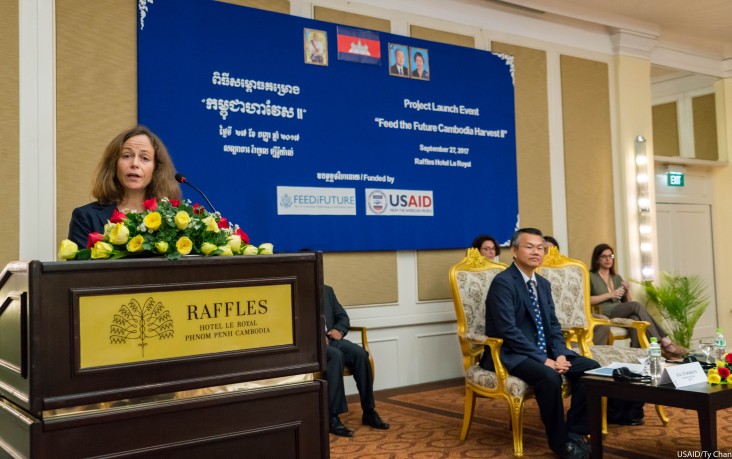Speeches Shim

(as prepared for delivery)
- Your Excellency, Ty Sokhun, Secretary of State for the Ministry of Agriculture, Forestry and Fisheries
- Excellencies, distinguished guests, ladies and gentlemen
Thank you so much for joining me to launch the Feed the Future Cambodia Harvest II program. Feed the Future is the U.S government’s initiative to end global hunger and improve food security around the world. The past success of Feed the Future in Cambodia came from the partnership between our two nations and people. That partnership continues to be strengthened by the real progress we are making to reduce poverty and hunger in Cambodia.
The new Feed the Future Cambodia Harvest II program will aim to accelerate growth in the commercial horticulture sector. We are focusing on this sector because Cambodia produces only one-third of the vegetables that its people consume at this time. The rest of the vegetables come from neighboring countries. Given that the agriculture industry employs over 70 percent of the population, we believe that Cambodia could be producing more healthy and nutritious vegetables to better feed its citizens. That is why we are working with the Cambodian government, businesses, universities here and abroad, and farmers to ensure that Cambodian agriculture can feed the Cambodia people.
The average growth rate of the horticulture sector in Cambodia between 2004 and 2012 was about 10 percent per annum, but this growth has recently slowed for a number of reasons. These include the lack of improved technologies and practices and limited access to markets.
The Ministry of Agriculture, Forestry and Fisheries also recognizes the potential for growth in the vegetable sector. In the Ministry’s Crop Master Plan 2030, vegetables are a priority for production. The Royal Government of Cambodia also envisions that the country will be mostly self-sufficient in safe vegetable production by 2030. USAID - through Cambodia Harvest II - is dedicated to supporting the government and farmers to reach this ambitious goal. Recognizing that the Cambodian government will invest millions of dollars in its Boosting Food Production Program 2016-2019, we will coordinate with the Ministry to ensure that we are using each other’s strengths to reach the ultimate goal: feeding Cambodia.
More broadly, the Feed the Future Cambodia Harvest II program continues the long-standing commitment of USAID support to the Royal government’s agriculture development priority. Our support to the horticulture value chain brings farmers, buyers, and consumers closer together. The Harvest II program will also improve the vegetable market system – that looks at all of the players working to produce, buy and sell vegetables – in the targeted provinces of Pursat, Battambang, Siem Reap, and Kampong Thom. This is a tall order and we will need to work with many of you in the audience to make this happen – government, private sector, other donors, and NGOs.
Over the past six years, Feed the Future programs in Cambodia have partnered with local government to do a better job of feeding Cambodia. We have collectively implemented better irrigation methods, decreased the use of pesticides, and found more effective ways to grow rice, vegetables, and farmed fish. As a result of our partnership, Cambodian farmers have boosted their incomes by $11.5 million per year and lifted 180,000 people out of poverty. This is an incredible achievement and we could not have done this without the support of the Provincial Departments of Agriculture, local farmers, other donors, and entrepreneurs who are building an equitable and dynamic private sector.
To see the true impacts of our programming and cooperation, I welcome you to visit the provinces where we work. Earlier this year I met with farmers who adopted an integrated vegetable farming system in Siem Reap. I am happy to note that they are earning an additional $150 to $200 per year. This additional resource allows them to buy books and clothes for their children so they can go to school. It also helped them buy a motorbike so they can find off farm-labor during the low season and reinvest into their farm so that next year, they will be able to increase their incomes even more.
Just last week I had the opportunity to visit farmers who grow small vegetables in their home gardens in Kampong Thom province. With simple and low cost technologies such as plastic or straw mulching and trellising, they increased their production to a new level. As a result, there is more food on the table, more food in the community, and fewer hungry children.
Each of us today is contributing to the larger effort of reducing poverty and malnutrition in Cambodia. Today’s launch of USAID Cambodia’s flagship Feed the Future Harvest II program will be one of the many ways that the U.S. government contributes to Cambodia’s continued success in ending hunger and food insecurity in Cambodia.
I would to thank you all for being here, we are here to solidify our commitment to working with you and supporting the great work that you all do in the vegetable sector. I am very proud of what we have accomplished together for the past six years, and I look forward to accomplishing much more over the next five years.
Thank you.
Related Speeches
- Remarks by Menglim Kim, Project Management Specialist, USAID/Cambodia, USAID Greening Prey Lang Final Youth Debate
- Remarks by Ms. Hanh Nguyen, Deputy Mission Director USAID/Cambodia, Health Professional Councils’ Strategic Planning Orientation Workshop
- Remarks by John Eyres, Director, Office of Public Health and Education, USAID/Cambodia, Dissemination Workshop of the Fifth National Strategic Plan for a Comprehensive & Multi-sectoral Response to HIV & AIDS in Cambodia

Comment
Make a general inquiry or suggest an improvement.